A tomato with huge fruits, proven for decades - "Russian size F1"
The first tomatoes brought to our country from South America were of very modest size and inexpressive taste. Thanks to modern breeding, this culture has changed a lot. Now on store shelves there are varieties and hybrids that differ in their bright taste, color and shape of the fruit.
Domestic agronomists keep up with their foreign colleagues. They release new varieties and hybrids of tomatoes every year. One of the most famous achievements of domestic breeding is the Russian size tomato. Its fruits amaze the imagination with their huge size, and the yield reaches 9 kg per square meter.
How to grow this unusual hybrid in your soda - read on.
The content of the article
General description of the hybrid
Russian size - tomato hybrid. It was bred by domestic gardeners almost two decades ago. It was entered into the Russian register in 2002.
Russian size tomatoes have been sold in horticultural markets for over 17 years. During this time, he has not lost his popularity. It is grown not only for personal purposes, but also on an industrial scale.
Distinctive features of tomato Russian size
The main feature of the Russian size hybrid is the gigantic size of its fruits. The smallest of them weigh 400 g. There are specimens weighing 2 kg. With their dimensions, they resemble a medium-sized pumpkin.
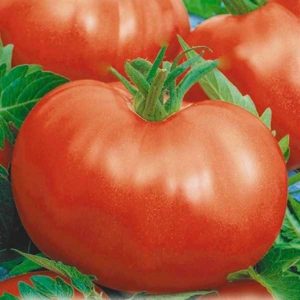 Despite its hybridity and large size, the fruits of this tomato have a pronounced sweet taste with almost no acidity. Tomatoes have a lot of pulp melting in the mouth, while they are juicy.
Despite its hybridity and large size, the fruits of this tomato have a pronounced sweet taste with almost no acidity. Tomatoes have a lot of pulp melting in the mouth, while they are juicy.
Russian size tomatoes are bright red in color. The fruits are consumed mainly fresh. It is also suitable for making ketchups and juices. Due to its size, it is not preserved whole. Gardeners say that they retain their shape when preserved in slices.
Russian size is immune to most tomato diseases, but sometimes late blight affects it.
This hybrid cannot be called unpretentious. It is picky about the composition of the soil and needs regular pinching and shaping. Therefore, it is grown only by experienced gardeners.
Main characteristics
Tomato Russian size is popular among gardeners. It has impressive performance.
Russian size description:
| Parameter | Indicators |
| Bush type | Indeterminate a tomato. Reaches a height of 1.8 m. In some cases it grows up to 2 m. The bushes are powerful and durable. They are highly branched and have a large number of leaves. The leaves are simple, not pubescent. The first inflorescence is formed at the 9th leaf level. The next, every 2 sheets. The inflorescences are simple. The fruits are formed on the clusters. Each cluster grows from 3 to 6 tomatoes, but the manufacturer recommends leaving no more than 3 berries. |
| Growing method | Cultivated exclusively in greenhouses. In open field conditions it does not reveal all its properties. |
| Yield | Average. From 1 sq. m it is possible to collect up to 9 kg of fruits with proper agricultural technology. |
| Fruit | Giant. On average, one berry weighs from 400 to 1000 g. Record specimens reach a mass of 2 kg. The color of the fruit is red on the inside and outside. There is no green spot at the base. Tomatoes have a round, flattened shape at the base.There is a slight ribbing at the base. Some fruits are irregular. There is a lot of pulp and it is juicy. The taste is sweet, intense, without pronounced sourness. In one berry, only 4 small chambers with seeds are formed, which are unsuitable for planting. |
| Transportability | Average. Tomatoes are suitable for transportation, but are stored for no more than a month. |
| Ripening terms | A late-ripening hybrid. Tomatoes ripen 128 days after sowing seeds. Ripe fruits can be tasted only in August. |
| Disease resistance | It has a high immunity to the tobacco mosaic virus, fusarium, cladosporium. |
Growing seedlings
Since the Russian size is grown exclusively by seedlings, its seeds are sown later than the planting material of many other varieties and hybrids. Sowing seedlings of this hybrid begins in early April.
Seed treatment
Before you start sowing seeds, you need to prepare them. The preparation of planting material includes 4 stages:
- Quality control of planting material... To do this, you need to look at the expiration dates on the packaging. Then the planting material is sorted out, removing all damaged and darkened specimens.
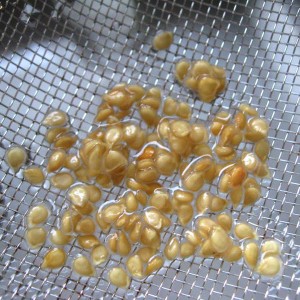
- Checking seeds for germination... The seeds are soaked in a solution made from 1 tsp salt and 1 tbsp. water for 30 minutes. Then all emerging instances are removed and thrown away. Those seeds that have sunk to the bottom are washed and used in the future.
- Etching of planting material. For this, the seeds are soaked in a disinfecting solution. There are several options for such means: a solution of soda (1 tsp with a slide for 1 tbsp. Water), aloe juice (aloe juice and water in equal proportions), "Fitosporin" (0.5 tsp. Powder per 100 ml of water ). In such means, the planting material is soaked for 12 hours. Another option is to soak the seeds in a solution of potassium permanganate for 30 minutes.
- Growth stimulation... Soda and phytosporin solution, as well as aloe juice, not only disinfect seeds, but also stimulate their growth. If a solution of potassium permanganate was used for etching, then the seeds are additionally treated with "Epin".
Note! Many manufacturers treat Russian size seeds with disinfectants. Information about this is indicated on the packaging. Usually, the treated seeds are colored green or orange.
Preparation of soil and containers
For growing seedlings, use any containers that are suitable in volume. If the seeds are planned to be sown in one container, then use large boxes, trays, deep disposable plates, packaging from semi-finished products.
For picking plants, 300 ml containers are used. Use special pots or disposable cups.
Another option is sowing seeds into individual peat tablets. It is considered the most convenient, but the most expensive.
The soil mixture for growing tomato seedlings should be nutritious and light. Suitable formulations are available from gardening stores. Many gardeners prepare soil for tomatoes on their own.
To prepare the soil for tomatoes, you need to take 1 part of garden soil (preferably from a greenhouse), 1 part of humus and 1 part of peat. To this mixture, add half a serving of sand or coconut substrate. To increase the nutritional value of the soil and reduce its acidity, a glass of ash and a matchbox of superphosphate are taken on a bucket of earth.
There is also a simpler soil option. For its preparation, black soil and sand are mixed in equal amounts.
Containers and soil must be disinfected. To do this, they are poured with boiling water or a solution of potassium permanganate. For containers, take a strong solution of potassium permanganate.
Sowing seeds
Experienced gardeners recommend sowing Russian-sized seeds immediately into individual containers. After all, the fewer seedlings picks, the healthier and more fruitful the bushes will turn out.
Peat tablets are the best option for growing this hybrid.Indeed, when planting seedlings in a greenhouse, the plants do not have to be removed from containers and disturbed by their root system.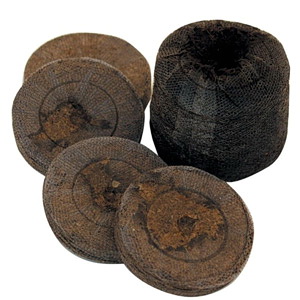
The cost of one tablet starts at 5 rubles. Therefore, when growing tomatoes in industrial seedlings, this option will be very costly.
When growing tomatoes for yourself, this method pays off.
Sowing seeds in peat tablets:
- The tablets are folded with the opening down. They are poured with boiling water.
- When the water is absorbed and the workpieces are swollen, more water is added.
- Swollen tablets are removed from the container and turned upside down. Seeds are immersed in peat, deepening them by 1 cm.
- Seed tablets are placed in one deep container, which is covered with a film and placed in a warm place.
Some gardeners plant seeds directly into individual pots. In this case, drainage and soil are poured into the container, after which the seeds are buried in the soil by 1 cm.
Seedling care
Russian-sized seedlings require regular maintenance. Only if all the rules are observed, the gardener will grow a healthy plant, which is a bountiful harvest of large fruits.
How to care for seedlings:
- Watering plants. Before the seeds germinate, the soil is moistened with a spray bottle. After the first shoots appear, use a watering can with a thin nozzle or a syringe. Water should not come into contact with plant greens. Be sure to use only settled water at room temperature.
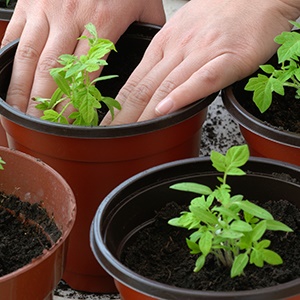
- Loosening the soil... The soil of tomatoes growing in individual containers must be loosened after each olive. It is convenient to do this with special miniature beds or an ordinary fork.
- If the seeds are sown in a common box, then the plants dive into individual containers after the first leaves appear. It is not recommended to pinch the root, this will slow down the growth of seedlings.
- Top dressing of seedlings. During the period of growing seedlings of Russian size, fertilizers are applied 2 times. The first time fertilization is applied 2 weeks after the appearance of the first leaves. The last one - 3 days before picking tomatoes in the greenhouse.
- Hardening of seedlings - a mandatory step even before planting it in the greenhouse (if it is not heated). Plants are taken outdoors 14 days before they are transplanted into the greenhouse.
When growing seedlings, gardeners face different challenges. The list contains the most common ones:
- Mold on the soil. It appears before the seeds germinate with excessive soil moisture. To get rid of it, remove the affected layer and water the ground with a weak solution of potassium permanganate.
- Loss of turgor and yellowing of seedlings. This indicates waterlogging or drying out of the soil.
- Withering of seedlings at normal soil moisture. This problem often arises if the seedlings are standing in a draft.
Growing tomatoes
Tomatoes Russian size are planted only in a greenhouse. Seedlings are planted in a permanent place in the second half of May.
Landing in a permanent place
Tomatoes are planted in a garden on which other nightshade crops have not grown for the last 3 seasons. Some gardeners change the soil even in the greenhouse.
In the fall, the beds are cleaned of all plant residues and dug up. If the acidity of the soil is increased, it is lowered with dry lime. To enrich the soil, cow dung is introduced into it.
In the spring, if necessary, the beds are cleaned of plant roots. Then dig holes. For 1 sq. m place no more than 3 plants. Long-acting mineral granules or ash are poured into the wells.
Seedlings are placed in the holes, which were removed from the pots along with a lump of earth. The depressions are covered with soil, and then watered. Use 1 liter of water per plant.
Basic rules of care
Hybrid Russian size required tie up... This must be done within a week after planting it in the greenhouse. To do this, use a strong wooden support, at least 1.8 m high. Plants are tied up only with synthetic thread.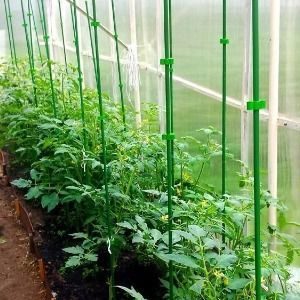
I form the bushes of that tomato into 1 or 2 steles.The more stems remain, the less the fruits will weigh and the later they will ripen.
Stealing plants should be regular and frequent. This hybrid forms a large number of stepchildren. Damaged leaves are removed along with unnecessary processes. In the lower part, the bush is completely cleaned of greenery.
Watered beds with tomatoes abundantly, but infrequently. Their strong root system is able to compensate for minor droughts. If you often moisten the soil with a small amount of liquid, then the tomatoes will crack.
Be sure to loosen the soil after each watering. Otherwise, an earthen crust is formed, which prevents root air exchange.
For the entire period of growing tomatoes in the greenhouse, 4 root dressings are applied. Mineral and organic fertilizers alternate.
Foliar dressing is applied twice a season. For this, plants are sprayed with boron products.
The nuances of growing Russian size
Russian size is considered a difficult hybrid to cultivate. There are several nuances of its cultivation, without the knowledge of which it will not be possible to get a good harvest:
- To get the largest possible fruits, the bushes are formed into 1 stem. If you leave 2-3 stepsons, then the tomatoes will weigh 400-600 g.
- Avoid feeding this hybrid with high nitrogen fertilizers. Otherwise, it will form a large number of stepchildren, which will negatively affect the yield. The Russian size needs to be fed with drugs that include potassium and phosphorus. Fishmeal is often used.
- All leaves up to 1 inflorescence are removed. Thanks to this, the fruits will be as large as possible.
- No more than 3 fruits are left on one brush. You need to choose the most correct ovary shape. To get berries with a paddle of more than a kilogram, one fruit is left on one brush.
Diseases and pests
The Russian size is highly immune to many tomato diseases. This hybrid does not suffer from fusarium wilting, tobacco mosaic and other viral infections.
However, due to the late ripeness of such tomatoes, they are often affected late blight.
To avoid this problem, follow the rules of prevention:
- All instruments that come into contact with plants are disinfected. Seeds, soil and greenhouse walls need processing.

- Weed your beds regularly. Weeds contribute to the development of diseases and negatively affect the root system of tomatoes.
- Monitor soil moisture. Any deviations from the norm create favorable conditions for the development of infection.
- Remove stepsons completely.
- For prevention, tomato plantings are sprayed with a solution potassium permanganate, copper sulfate or Fitosporin.
- Large pests are harvested by hand. A soap solution will help get rid of aphids. To protect against other pests that affect the ground part of the bush, an infusion of celandine is used.
Growing in a greenhouse and open field
Tomato Russian size in open ground is grown only in the southern regions of our country, but even in a warm climate, its yield indicators will be lower than in greenhouses.
When growing tomatoes in a greenhouse, it is important to process the walls of the room. For this, copper sulfate or a solution of potassium permanganate is used.
To maintain optimal humidity, the room is ventilated daily by opening all windows.
Harvesting and application of the crop
Tomatoes Russian size ripen in August. At maturity, they are red without green spots.
Ripe fruits are cut with a knife or picked by hand. It is important to leave the stalk, which increases the keeping quality of the berries.
The use of the crop is universal, however, fruits are not very suitable for whole-fruit conservation due to their size.
Advantages and disadvantages of a hybrid
Benefits of Russian size tomatoes:
- giant fruits;
- wonderful sweet taste;
- immunity to tomato diseases.
Of the shortcomings, the whimsicality of the tomato and the low yield in the open field are noted.
Reviews of farmers about tomato Russian size
The Russian size has positive reviews from gardeners. Despite all the difficulties of growing it, gardeners are happy with the result.
Ksenia Ivanova, Moscow «The Russian size is my favorite hybrid. Every year I plant him in a greenhouse. Yes, you need to take care of it regularly, but it is worth it, His fruits have a rich sweet taste. The largest tomato I have ever grown weighed 1.4 kg. "
Alena Krikunova, Sochi “For the third year now I have been planting Russian size. I really like its huge fruits. They turn out just like in the photo. Some berries do not fit in the palm of your hand. We eat all tomatoes fresh. "
Conclusion
Tomato Russian size is really worth the attention of gardeners. Fruit of record sizes grow on it. Some of them resemble a small pumpkin in size.
It takes a lot of effort to grow this hybrid. He needs regular care and requires certain skills in growing whimsical crops. Therefore, the Russian size is suitable only for experienced gardeners.